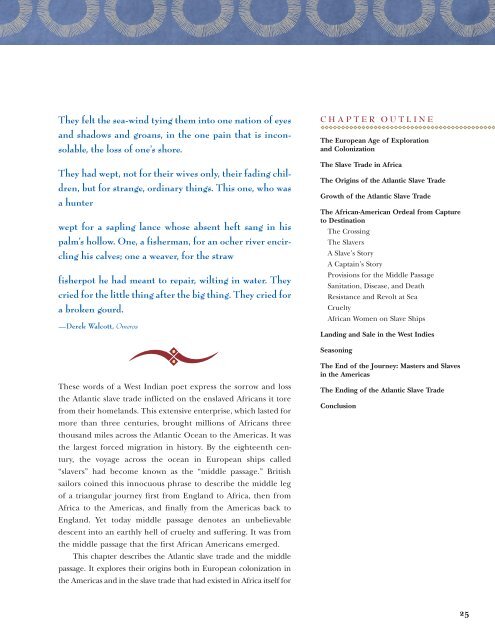You also want an ePaper? Increase the reach of your titles
YUMPU automatically turns print PDFs into web optimized ePapers that Google loves.
They felt the sea-wind tying them into one nation of eyes<br />
and shadows and groans, in the one pain that is inconsolable,<br />
the loss of one’s shore.<br />
They had wept, not for their wives only, their fading children,<br />
but for strange, ordinary things. This one, who was<br />
a hunter<br />
wept for a sapling lance whose absent heft sang in his<br />
palm’s hollow. One, a fisherman, for an ocher river encircling<br />
his calves; one a weaver, for the straw<br />
fisherpot he had meant to repair, wilting in water. They<br />
cried for the little thing after the big thing. They cried for<br />
a broken gourd.<br />
—Derek Walcott, Omeros<br />
These words of a West Indian poet express the sorrow and loss<br />
the Atlantic slave trade inflicted on the enslaved Africans it tore<br />
from their homelands. This extensive enterprise, which lasted for<br />
more than three centuries, brought millions of Africans three<br />
thousand miles across the Atlantic Ocean to the Americas. It was<br />
the largest forced migration in history. By the eighteenth century,<br />
the voyage across the ocean in European ships called<br />
“slavers” had become known as the “middle passage.” British<br />
sailors coined this innocuous phrase to describe the middle leg<br />
of a triangular journey first from England to Africa, then from<br />
Africa to the Americas, and finally from the Americas back to<br />
England. Yet today middle passage denotes an unbelievable<br />
descent into an earthly hell of cruelty and suffering. It was from<br />
the middle passage that the first African Americans emerged.<br />
This chapter describes the Atlantic slave trade and the middle<br />
passage. It explores their origins both in European colonization in<br />
the Americas and in the slave trade that had existed in Africa itself for<br />
CHAPTER OUTLINE<br />
The European Age of Exploration<br />
and Colonization<br />
The Slave Trade in Africa<br />
The Origins of the Atlantic Slave Trade<br />
Growth of the Atlantic Slave Trade<br />
The African-American Ordeal from Capture<br />
to Destination<br />
The Crossing<br />
The Slavers<br />
A Slave’s Story<br />
A Captain’s Story<br />
Provisions for the <strong>Middle</strong> <strong>Passage</strong><br />
Sanitation, Disease, and Death<br />
Resistance and Revolt at Sea<br />
Cruelty<br />
African Women on Slave Ships<br />
Landing and Sale in the West Indies<br />
Seasoning<br />
The End of the Journey: Masters and Slaves<br />
in the Americas<br />
The Ending of the Atlantic Slave Trade<br />
Conclusion<br />
25

















